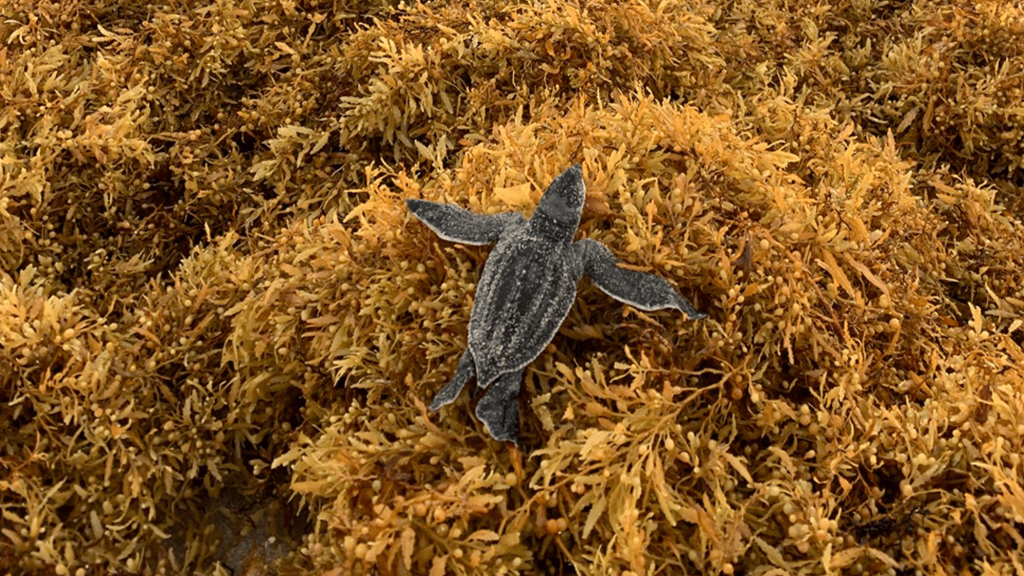Sargassum. The smelly, brown seaweed can put a damper on a day at the beach at best and hinder baby turtles on their way to the ocean at worst. Only about one in 1,000 sea turtle hatchlings survive to adulthood, and Sargassum might be added to their already long list of challenges.
The new findings detailed in a study published in the Journal of Coastal Research explores the role that this brown seaweed plays on vulnerable sea turtle populations.
“For sea turtle hatchlings, reaching the ocean is already a race against time – and survival. Now, increasingly large mats of sargassum are adding new challenges to this critical journey,” study co-author and Florida Atlantic University biologist Sarah Milton, said in a statement. “As these seaweed accumulations grow taller and more widespread, they risk blocking hatchlings entirely, draining their limited energy or leaving them stranded. Beyond impeding movement, sargassum may also reduce nesting space and alter incubation conditions.”
What is Sargassum?
Sargassum is a genus of large brown seaweed. It floats along the ocean in island-like masses and does not attach to the seafloor the way that kelp does. It is abundant in the world’s oceans, and has many leafy appendages, branches, and its signature berry-like structures. Those round “berries” are actually gas-filled structures called pneumatocysts that allow them to float on the surface of the water, similar to a life jacket.
While considered a nuisance to many, Sargassum does provide food and a floating habitat for several marine species, including various fish species, sea turtles, marine birds, crabs, and shrimp.
Sargassum blooms are also increasing. In June 2025, a record 38 million tons of the seaweed were measured in the Caribbean Sea, with huge clumps turning up on beaches in Florida. These clumps can put already vulnerable sea turtle hatchlings in trouble.
“The longer a hatchling stays on the beach, the more at risk it becomes – not just from predators like birds and crabs, but also from overheating and dehydration, especially after sunrise,” said Milton. “When sargassum piles are higher – some can be over a meter [about 3 feet] high on South Florida beaches in the summer and extend for hundreds of meters down the beach – we can expect more failed attempts, particularly when hatchlings have to cross multiple bands of seaweed just to reach the ocean.”
A Sargassum obstacle course
The study focused on three common sea turtle species found in Florida: leatherbacks (Dermochelys coriacea), loggerheads (Caretta caretta), and green turtles (Chelonia mydas) from three Atlantic Ocean facing beaches in southern Florida (Juno Beach, Jupiter, and Boca Raton). From March through October, sea turtles lay their eggs in the sand of these beaches. They usually lay between four and 10 clutches, with each clutch containing between 70 and 140 eggs, depending on the turtle species. It can generally take the baby turtles anywhere from 10 to 30 minutes to reach the ocean.
The researchers created controlled crawl-ways on the sand as a way to simulate a hatchling’s natural path to the water, adding loose mats of Sargassum at various heights up to 7.5 inches high at the end of a 49 foot path. A dim light was placed several feet ahead to guide the hatchlings forward. This light was meant to simulate the natural light over the ocean that they instinctively follow. This way, the team could directly measure the physical toll of crawling through sargassum from a distance, and avoid interfering with their natural behavior. They also tested several turtles on a non-Sargassum filled path as a control group.
After completing the Sargassum obstacle course, the team measured the hatchlings’ blood glucose levels to assess their energy usage. They also tested how quickly each turtle could flip itself upright when placed upside down in water to assess their physical condition after the crawl. Sand temperature at the beginning, middle, and end of each crawl was also measured.
Hatchlings from all three species took significantly longer to complete their crawl when the sargassum was present. The extra time spent climbing up and over the seaweed piles was the primary reason for the slowdown.
The hatchlings also flipped upside down when trying to climb up the seaweed, with one hatchling flipping more than 20 times on a single trial. These flips–called inversions– extended the dangerous time hatchlings spent on the beach and increased their risk of getting eaten and being exposed to stifling summer heat.
However, despite these travel delays and the challenges of navigating the seaweed, the team did not find any significant differences in blood glucose levels between the hatchlings that crawled through sargassum and the ones that didn’t. The glucose concentrations on all species remained within expected ranges.
According to the team, this suggests that while the extra seaweed increased the effort and risk, it didn’t immediately deplete the turtles’ measurable energy stores. The only group to see noticeably higher glucose were leatherback hatchlings from the no-crawl control group. The act of crawling in general, and not the Sargassum itself has a stronger physiological impact, at least during the short term.
Understanding how this affects sea turtles could lead to more responsive beach management strategies to help sea turtles on their journey to the ocean.
[ Related: 7 wild photos. 40 years of data. 1 smelly seaweed story. ]
Sea turtle nesting season do’s and don’ts
Florida Atlantic University has a list of best practices if you should encounter sea turtle hatchlings during nesting season.
If you see a turtle laying eggs, leave her alone. Additionally contacting the Florida Fish and Wildlife Conservation Commission Division of Law Enforcement is crucial if you spot an injured or stranded sea turtle. It is also important to keep dogs leashed and away from turtle nests.
As much as you may want to help a hatchling, do not touch it. State and federal laws prohibit removing the hatchling from its natural environment.
Guided “turtle walks,” participating in beach clean-ups, and minimizing the use of single-use plastics are also easy ways to get involved in sea turtle conservation.


